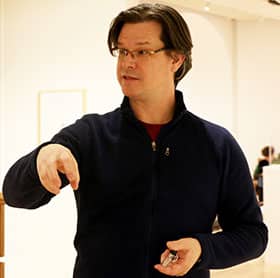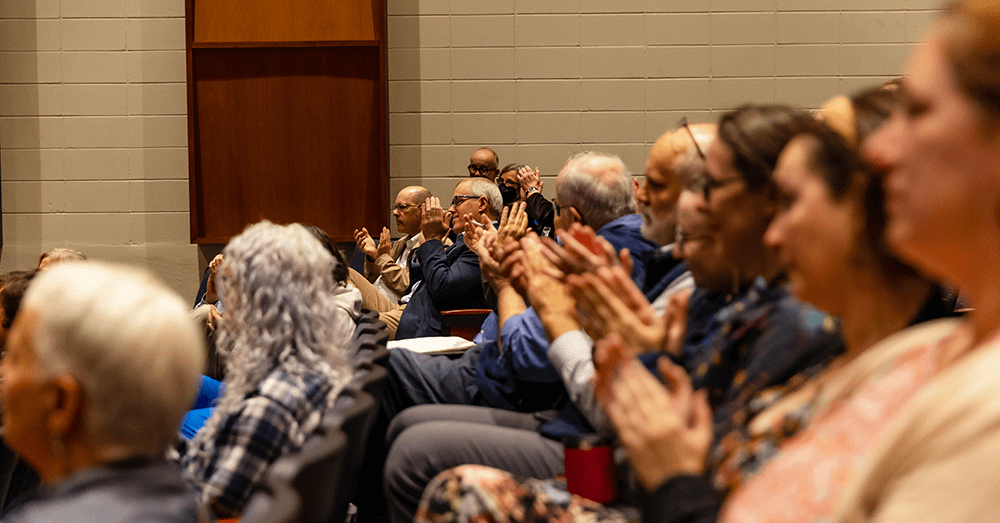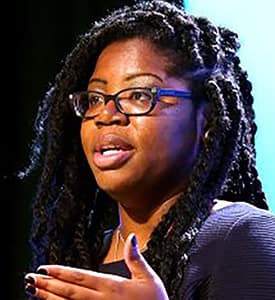Design offerings in art major
Design offerings boost appeal of Saint Michael's art major

The image directly above is of Brian Collier of the fine arts faculty, who explained design additions to the curriculum in his department recently. (Top photo by Tess Beinhaur ’20, Collier portrait by Eva Wilton ’19)
“Artists don’t just do one thing anymore,” says Brian Collier of the Saint Michael’s College fine arts faculty, explaining why more design offerings are being incorporated into the curriculum for art majors come fall of 2019.
The former “Art” major at Saint Michael’s now will be called “Art and Design.” Collier says for some time now he’s been hearing requests from Saint Michael’s art students for more technology-based opportunities, so the recent expansion of graphic design and other design-related offerings reflect the need for versatility in today’s artists. Design provides “a lot of employment flexibility and options for different things you could do to support yourself in a creative practice,” he says.
Art and economics double-major and soon-to-be senior, Megan Ahearn ’20 couldn’t agree more. Mentioning the “starving artist” stereotype — the very reason she chose to add economics to her repertoire in the first place — she reflects that being skilled in design and computer generated art programs is “a necessity in order to make anything in a professional world now.” While Ahearn enjoys the “small community vibe” that comes with being one of nine art/design majors in the class of 2020, she is excited about the growth that is expected to occur as a result of the addition, and believes it will bring a much needed “professional perception” to the major.
This change has been a long time coming, says Collier, who first heard talk about incorporating graphic design into the program not long after he started his professorship at the College in 2011. Those conversations led to additional design elements that are already in the curriculum such as website design, printers and print output, and logo design.
However in today’s increasingly competitive market of career-oriented students, Collier says, it’s not enough to just quietly have such courses – it’s important to proclaim them for the benefit of prospective students, employers, and other external onlookers. Before the name-change, these constituents were not able to fully see the strong design background with which Saint Michael’s art students graduate. Collier and his colleagues came to realize that their program’s name needed to more explicitly market those elements most in demand among students. Officially adding “design” to the art program name felt like the obvious fix.
Five new course offerings starting this fall will provide substantial validation for the new major-name: motion graphics, furniture design and making, intro to graphic design, design for print, and design for web and devices. Collier hopes to eventually add a 3D modeling class, which he says is crucial for students looking to go into architecture and for employers seeking them out.
Collier was excited to announce that the faculty team of two (himself and colleague Will Mentor) soon will become three with the recently approved addition of a design professor who will help to make further changes to the curriculum. “It’s going to be a great way to build out the program and gain a lot more student interest,” he says.
At the heart of this change is a strategic and thoughtful adherence to the principles that guide Saint Michael’s College and liberal arts education. “It is all scaled to a Saint Michael’s scale,” Collier says, “and is designed to meet a lot of different skill levels in every class and to still maintain that one-on-one student/faculty ratio that we pride ourselves on.”
Collier also highlights an “important marriage between the graphic-design applied tools and the fine arts model of education.”
“Just learning the tools of graphic design doesn’t make you a good graphic designer,” he says. “You have to understand the environment it’s going in. You have to understand creative exploration. You have to understand innovative thinking.”
Collier hopes that the mergence between graphic design and creative art forms will work to further his professional mission: “to send students out in the world who don’t only have the tools to do the stuff, but have the ability for independent, innovative, creative problem solving and thinking that will make them stand out from the crowd of everyone else who just knows the tools.”





